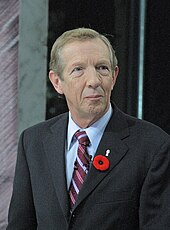Lorne Calvert
Lorne Albert Calvert (born December 24, 1952 in Moose Jaw , Saskatchewan ) is a Canadian politician and minister of the United Church of Canada . From February 8, 2001 to November 21, 2007, he was Prime Minister of Saskatchewan Province. He has been a member of the Saskatchewan Legislative Assembly since 1986 and was chairman of the Saskatchewan New Democratic Party (NDP) from 2001 to 2009 , most recently as leader of the opposition.
Profession and Provincial Politics
Calvert grew up in Moose Jaw. After leaving school, he studied economics at the University of Saskatchewan , then theology at the seminary at St Andrews College in Saskatoon . One year after her marriage to Betty Sluzalo, she was ordained a clergyman in the liberal United Church of Canada in 1976 . He then led churches in various small towns in Saskatchewan and from 1979 to 1986 the Zion United Church in Moose Jaw.
Influenced by his father, who had supported the social democratic Co-operative Commonwealth Federation for many years , Calvert joined the successor party NDP. In the election for the legislative assembly in 1986, he ran successfully in the constituency of Moose Jaw South, where he spoke out vehemently against the planned construction of a casino. In 1991 and 1995 he was confirmed in the constituency of Moose Jaw Wakamow. In 1992 Prime Minister Roy Romanow appointed him Minister in charge of the state-owned companies SaskPower and SaskEnergy, and in 1995 Minister of Health.
prime minister
Calvert did not run for the 1999 election because he took a two-year hiatus to spend more time with his family. On January 27, 2001, he was elected as the new chairman of the NDP, on February 8, he took over the office of head of government from the resigning Romanov. A month later he won the by-election in Romanov's former constituency, Saskatoon Riversdale. Since the NDP did not have an absolute majority of the seats, he led a coalition government with the Saskatchewan Liberal Party .
In the November 2003 election, the NDP was able to gain one seat and now had an extremely narrow absolute majority with 30 out of 58 seats. Calvert continued Romanov's course, continued to position the NDP in the middle of the political spectrum and pursued a cautious fiscal policy. The opposition Saskatchewan Party , which had previously followed a more conservative course, now also moved towards the center and was able to leave the NDP behind in opinion polls, especially in rural areas.
further activities
On November 7, 2007, the NDP lost more than 7% of the vote in the election. Calvert resigned as head of government two weeks later and handed over the office to Brad Wall . The federal New Democratic Party asked Calvert if he would run in the 2008 general election. However, the latter declined the offer, but promised to get involved in the election campaign. On October 16, 2008, he announced his impending resignation as chairman of the Saskatchewans NDP. On June 6, 2009, Dwain Lingenfelter was elected to succeed him.
Web links
- Lorne Calvert's website
- Lorne Calvert ( English, French ) In: The Canadian Encyclopedia .
- Article Lorne Calvert in the Encyclopedia of Saskatchewan
Individual evidence
- ↑ Federal NDP woo Calvert for election ( Memento of the original from November 3, 2012 in the Internet Archive ) Info: The archive link was inserted automatically and has not yet been checked. Please check the original and archive link according to the instructions and then remove this notice. , Saskatoon StarPhoenix, November 20, 2007
- ↑ Calvert all but rules out federal politics ( Memento of the original from May 11, 2011 in the Internet Archive ) Info: The archive link was automatically inserted and not yet checked. Please check the original and archive link according to the instructions and then remove this notice. , Regina Leader-Post, November 23, 2007
- ^ Tributes paid to Lorne Calvert on the final day as Sask. NDP leader , CBC News, June 5, 2009
| personal data | |
|---|---|
| SURNAME | Calvert, Lorne |
| ALTERNATIVE NAMES | Calvert, Lorne Albert (full name) |
| BRIEF DESCRIPTION | Canadian politician, minister of the United Church of Canada |
| DATE OF BIRTH | December 24, 1952 |
| PLACE OF BIRTH | Moose Jaw |
